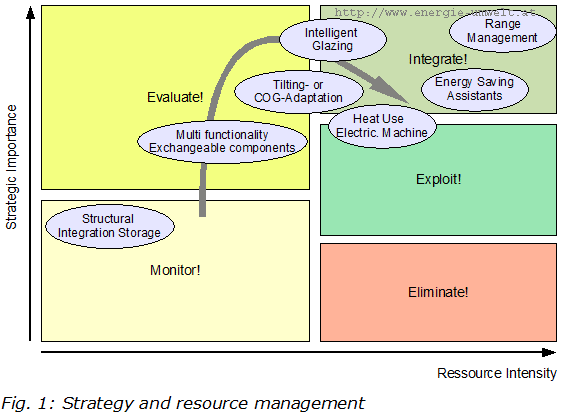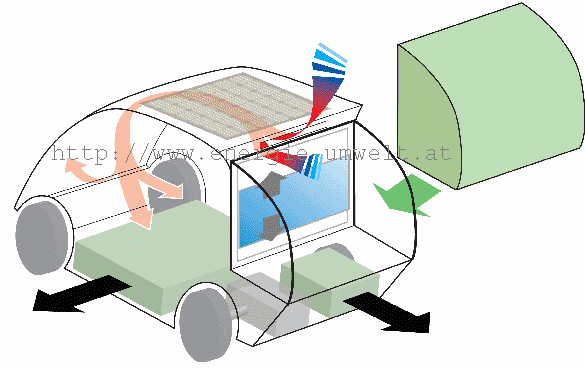
Paradigm Change in
Propulsion Technology/Public Summary
Contact Author: +43 (0) 680 2141094 E-mail
contact form

|
|
Paradigm Change in
Propulsion Technology/Public Summary
|
|
The Project PiA (paradigm change in propulsion technology) aimed to sound out innovations contributing to the facilitation of the use of light battery electric vehicles though new approaches. Within the last 3 month a physicist, an electrical engineer and 3 mechanical engineers have dealt with solutions so far not existent in the motor industry in that form. In addition to various considerations and calculations a Delphi survey was carried out to obtain the opinion of experts concerning the feasibility of approaches and new suggestions. Last but not least, users were interviewed with regard to the acceptance of new usage paradigms. To further increase the degree of innovation the ground-breaking approaches were not only analysed but also further modified and combined. This resulted in solutions ensuring that:
Narrow ultra light vehicles do not turn over during the Elk-tests with the help of a dislocation of the batteries
Batteries have on average a higher operating temperature in winter and that the vehicle therefore has a longer operating distance, due to the usage of environmental temperature/solar energy/waste heat and heat storage
Through an intelligent usage of solar radiation the inside of the vehicle will be kept warm in winter without reducing the range by the use of electrical heating
The range of the vehicle will be extended through assisting the driver, e.g. when accelerating or braking
Based on predictive control, the driver is given support allowing to drive more energy efficient and thus extending the distance,
Electric machines can be built lighter and utilized better (higher power per mass
unit) through new cooling and operating concepts.

The innovations were sorted according to evaluations and chronological appearance. Beside positively evaluated measures, possibly appearing consecutively, other measures exist and sometimes their market entry was presumed to be later, despite a high rating. Such measures shall be monitored at first. With regard to the rating much depends on the markets envisaged. Certainly, in Europe, Japan and the US high demands are put on safety and comfort, whereas in the emerging markets different criteria prevail which are better covered by light battery electric vehicles.
Especially measures that dispel reservations against electric vehicles or are indirectly related to them need a higher input of resources during development. Thus, otherwise less attractive ideas gain new importance.
Due to their high investment costs conventional electric vehicles will not achieve a high market penetration medium-term. Cost calculations during the project have demonstrated clear advantages for modular concepts and new interesting ownership models result from it too.
However,
it is also evident that particularly open modular concepts breach
the interests of established OEMs. Latest announcements of OEMs to
offer different ranges and adding modularity to the battery system
indicate that mobility
costs
for citizens will drop despite zero emission.
Fig. 2: Visualization
of approaches to modularity and hot air system
The project has pointed out a multitude of interesting possible developments that could be best extended in the form of an Light vehicle cluster. Light vehicles have weaker requirements due to smaller masses to be manipulated with modular concepts and also the demands of the customers are lower. Whilst producers possess the Know-how to advance the development in all areas addressed and prototypes like the CLEVER have been seen, user acceptance of light vehicles requires a structural change of the play in road transport – where heavier vehicles have the better standing. To allow a faster production of emission free urban vehicles, the appropriate legal and economic framework needs to be created guaranteeing safety of light battery electric vehicles. Due to the fact that in many areas the need for action arises anyway, because of the immission problem, a synergy does exist between environmental and industrial policy supporting the introduction of city electric vehicles.
Funded by the FFG within the A3Plus program which was initiated by the bmvit. PiA is a cooperation between Energie- und Umweltconsulting DI. Gerfried Cebrat and Austrian Mobility Research. The statements solely express the opinion of the authors. No liabilities whatsoever may be deducted when applying the findings.